The Ultimate Guide to Gardens for Dummies: Green Thumb Made Easy is a comprehensive resource for novice gardeners, offering a wealth of information on gardening basics and providing valuable tips for those starting out in the world of gardening. Whether you have a sprawling backyard or just a few pots on a balcony, this guide will help you kickstart your gardening journey successfully.
The guide covers various topics, including selecting the right plants for your garden, understanding soil science and composting, essential tools and equipment, garden layout and design possibilities, pest management, indoor gardening, year-round planting, harvesting tips, troubleshooting common issues, and the benefits of joining gardening communities. The guide emphasizes the importance of soil fertility, proper watering techniques, and regular maintenance to ensure healthy plant growth.
Key Takeaways:
- The Ultimate Guide to Gardens for Dummies is a comprehensive resource for beginner gardeners.
- The guide covers topics such as plant selection, soil science, essential tools, design possibilities, pest management, indoor gardening, year-round planting, and troubleshooting common issues.
- The guide emphasizes the importance of soil fertility and proper watering techniques.
- Joining gardening communities can provide additional guidance and support for beginner gardeners.
Choosing the Right Plants for Your Garden
Choosing the right plants for your garden is crucial for the success of your gardening endeavor. As a beginner, it’s important to select plants that are easy to care for and suitable for your specific space. Tomatoes, basil, and marigolds are great options for beginners.
When selecting plants, consider factors such as sunlight availability, water demands, and the size of your space. Some plants need full sun, while others thrive in partial shade. Understanding soil types, drainage, and nutrient balance is also important. Composting kitchen scraps and garden waste is an excellent way to enhance your soil’s fertility naturally.
It’s also essential to equip yourself with the right tools. A spade, pruners, gloves, and a watering can are must-haves for a smoother gardening experience. Proper planning is essential, so design your garden layout to maximize sunlight exposure and optimize space. Regular maintenance, including pruning, weeding, and staying vigilant for signs of ailments, is necessary for a thriving garden.
Pest management is another crucial aspect. Eco-friendly solutions like neem oil or introducing beneficial insects can be effective. Consider your gardening style and choose a design that resonates with your taste and space. Indoor gardening is also a great option for those with limited outdoor space, and plants like succulents and herbs thrive indoors on windowsills and counters.
Different seasons welcome different plant varieties, so research optimal planting times for specific vegetables, flowers, and herbs to maximize growth. Finally, joining local gardening clubs and online forums is an excellent way to share experiences and learn from seasoned enthusiasts.
By choosing the right plants and following these guidelines, you can create a vibrant and thriving garden.
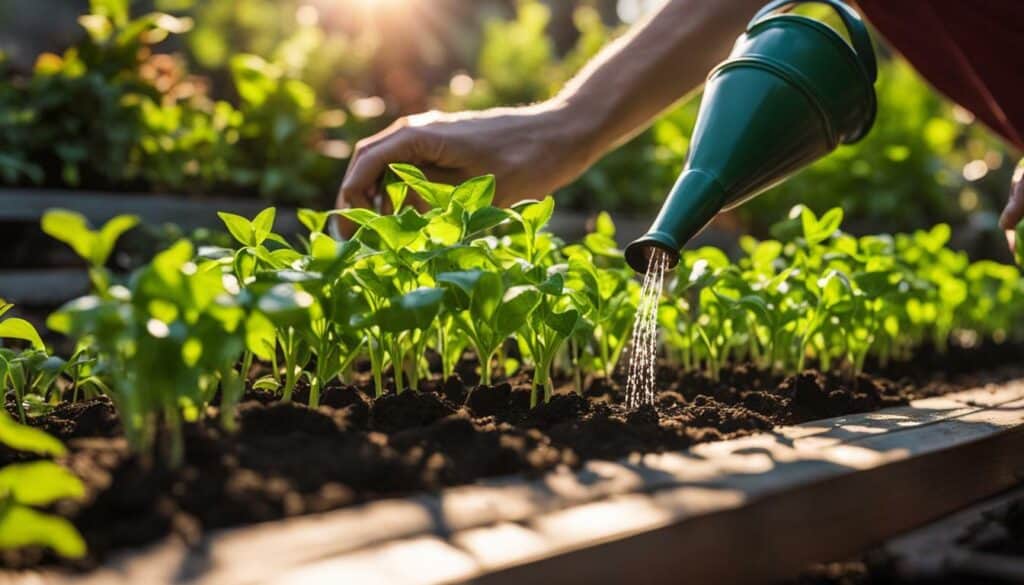
The Basics of Soil Science
Understanding the basics of soil science is essential for any aspiring gardener. Healthy soil is crucial for a thriving garden. Soil composition, drainage, and nutrient balance can vary based on several factors such as location and climate.
There are different types of soil, including clay, loam, and sand. Each type has unique characteristics that affect plant growth. Understanding how to optimize soil health involves learning about pH levels, nutrient deficiencies, and organic matter content. Composting kitchen scraps and garden waste is a natural way to enhance soil fertility.
Equipping yourself with the right gardening tools such as a spade, pruners, gloves, and a watering can is essential for a smooth gardening experience. Designing your garden layout to maximize sunlight exposure and optimize space is crucial. Raised beds are particularly beneficial for beginners.
Precise watering is key – water deeply but infrequently to encourage deep root growth. Mulching can help retain moisture and suppress weed growth. Regular maintenance, such as trimming away dead branches and tackling weeds, is necessary for a thriving garden.
Pest management is crucial – identify pests and explore eco-friendly solutions before resorting to chemical interventions. Also, there are various gardening styles to choose from, so select one that aligns with your taste and space.
Indoor gardening is a viable option for those with limited outdoor space. Many plants, such as succulents and herbs, thrive indoors. Different plants thrive in different seasons, so research optimal planting times for specific vegetables, flowers, and herbs.
Harvest your fruits and vegetables when they are ripe to enjoy the fruits of your labor. Troubleshoot common gardening issues like yellowing leaves, pests, and diseases. Educate yourself on identifying and combatting these problems effectively.
Connect with local gardening clubs and online forums to share experiences and learn from seasoned enthusiasts. Understanding the basics of soil science will empower you to create a vibrant and thriving garden. Gardening can be a rewarding and enjoyable experience for beginners and experienced gardeners alike.

Essential Tools for the Budding Gardener
Having the right tools is crucial for any beginner gardener. These essential tools will equip novice gardeners with everything they need to kickstart their gardening journey successfully:
| Tool | Description |
|---|---|
| Spade | A shovel-like tool used for digging, lifting, and moving soil and other materials. |
| Pruners | A cutting tool used for trimming shrubs, trees, and other plants. |
| Gloves | To protect hands from thorns, sharp edges, and irritants in the soil or plants. |
| Watering can | A container used for watering plants, making it easier to control the amount of water plants receive. |
| Garden hose | Used for watering a large area of plants. |
| Shears, loppers, or pruners for trimming plants | Used for trimming plants, especially those with thicker stems and branches that cannot be easily cut with regular pruners. |
| Rake or garden hoe for smoothing and breaking up soil | A rake to remove debris and a garden hoe to break up soil clumps. |
| Garden fork or spade for moving soil | A garden fork or spade for moving soil or other materials around the garden. |
| High-quality, sturdy tools for a smoother gardening experience | Investing in high-quality, sturdy tools will make for a smoother gardening experience and save money in the long run. |
Whether you have a sprawling garden or a small balcony, these tools are indispensable for creating a flourishing garden. Other important factors for new gardeners include selecting suitable plants for their space, mastering soil science and composting, and designing their garden layout to maximize sunlight exposure. Regular maintenance and pest management are also crucial for maintaining a thriving garden. Additionally, joining gardening communities and online forums can provide valuable insights and guidance for budding gardeners.
Remember: As a beginner gardener, having the right tools is essential. Don’t skimp on quality, as investing in sturdy and efficient tools can make all the difference.
Designing Your Garden Layout
Designing the layout of your garden is an exciting opportunity to showcase your personal style. One of the first considerations to keep in mind is the size and shape of your outdoor space. If you have a small yard or patio, consider utilizing vertical space by placing plants on shelves or hanging baskets. Choose plants based on the amount of sunlight your garden receives and the local climate.
When selecting plants, think about the purpose of your garden. Are you looking to create a vegetable garden to grow your own produce, or do you want to cultivate a flower garden for aesthetic purposes? You can also blend both by interspersing flowers between vegetable rows.
Maximizing sunlight exposure is crucial for healthy plant growth. Position taller plants on the north side of your garden to prevent them from casting shadows on smaller plants. You can also use raised garden beds to optimize space and enhance drainage.
Equipping yourself with the necessary tools, such as a trowel, pruning shears, and a watering can, is essential for maintaining your garden. Regularly remove weeds and address pest issues, such as aphids or slugs, to ensure your plants thrive.
Some easy garden ideas for beginners include using container gardens, incorporating decorative elements such as stepping stones or bird baths, and adding a focal point such as a statue or trellis. By following these tips and techniques, you can create a flourishing garden that suits your personal style and preferences.
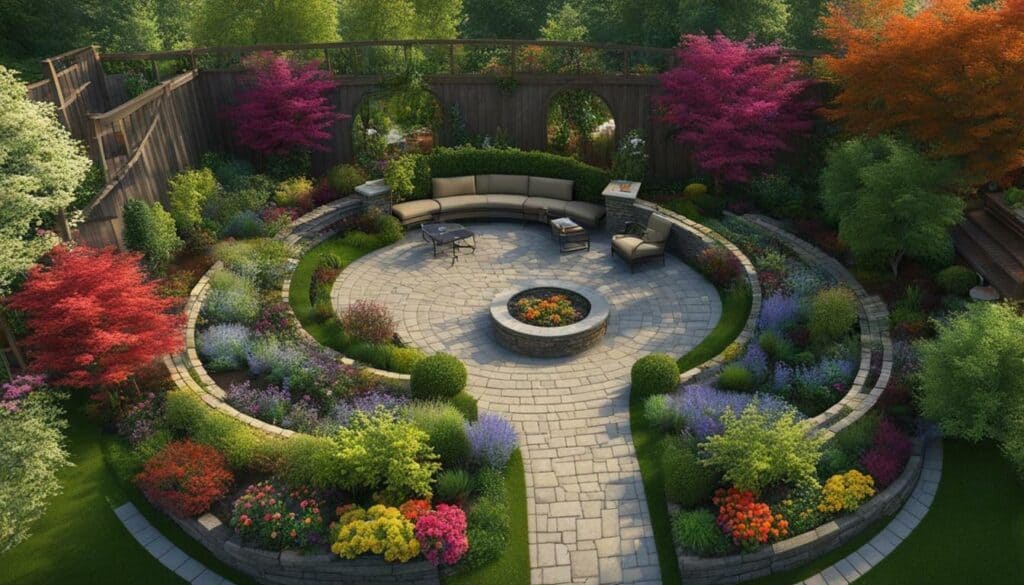
Watering Techniques for Healthy Plants
Proper watering techniques are essential for maintaining healthy plants in your garden. One important rule to remember is to water deeply and infrequently to encourage deep root growth. This watering method ensures that the roots grow down to access moisture, making plants more resilient to drought. Mulching is another technique that can help retain moisture and control weed growth.
Precise watering is crucial, which means the frequency and amount of water depends on various factors like plant type and weather conditions. Water frequency should aim for soil dampness rather than saturation, which can lead to root rot and other issues. The best time to water is in the morning or evening to avoid evaporation.
Swiftly identifying and addressing pest issues is crucial to prevent widespread damage. Some natural pest control methods include spraying neem oil, planting companion plants to deter pests, or manually removing pests. It’s important to try natural methods before resorting to chemicals.
Year-round planting requires research and knowledge of planting schedules specific to your region. Different seasons require different planting times and techniques. Joining gardening communities can provide support and knowledge sharing for making the most of your garden year-round.

Container gardening is a suitable option for limited outdoor space, allowing you to grow a variety of plants in smaller areas. Indoor gardening is also possible with proper care and lighting. Troubleshooting common plant issues like yellowing leaves or stunted growth, and knowing when to prune or fertilize, is necessary to maintain a healthy garden.
Pest Management Made Easy
When it comes to pest management in your garden, there are easy and natural methods you can employ. It is essential to keep pests at bay to ensure your plants’ health and yield optimal results. Good planning and regular maintenance are crucial in preventing pests from taking over your garden.
One of the easiest methods of natural pest control is companion planting. Certain plants have natural repellent properties that can deter pests from attacking nearby plants. For instance, planting marigolds alongside tomatoes can discourage nematodes and aphids, while basil can help repel mosquitoes and flies. Additionally, crop rotation can prevent pests that overwinter in the soil from attacking the same plants year after year.
Another natural pest control method is handpicking insects from your plants. It may seem tedious, but it’s a great way to control populations before they become too large. Make sure to wear gloves and look for insects during early morning or late evening hours when they are most active.
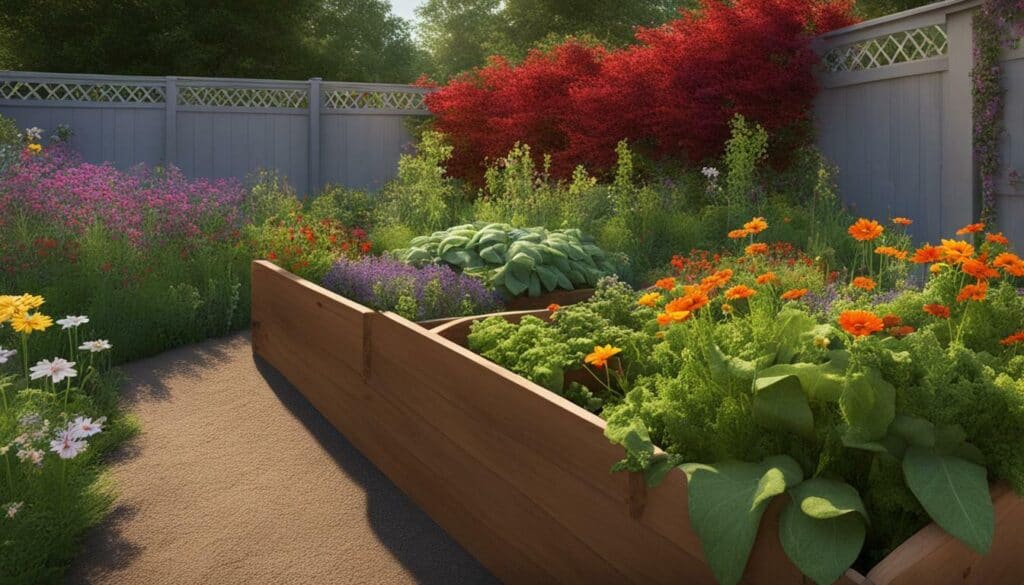
Organic sprays such as neem oil, garlic oil, and insecticidal soap can also help control pest problems without harming beneficial insects. These sprays work by suffocating the pests or disrupting their feeding patterns. Be sure to follow the product instructions carefully, as an excessive application of organic sprays can harm your plants.
Joining gardening communities and online forums can also provide valuable insights and guidance on dealing with pests. You can learn about different pests and their behaviors, as well as effective methods of eradication. Take advantage of the experience of more seasoned gardeners to avoid making mistakes and optimize your gardening results.
With the right knowledge and tools, pest management can be manageable and even enjoyable. Natural pest control methods not only protect your garden but also contribute to a healthier environment. By employing these methods, you can create a thriving garden that is pest-free and yields excellent results.
Indoor Gardening: Bringing the Outdoors In
Indoor gardening allows you to enjoy the beauty of plants within the confines of your home. It’s a wonderful way to bring the outdoors in, especially for those who don’t have the luxury of a garden or outdoor space. With the right plant selection, healthy soil, and proper care, you can grow a thriving indoor garden that will enhance your living space with greenery, oxygen, and aesthetic appeal.
When it comes to indoor gardening, choosing the right plants is key. Succulents, herbs, and small leafy greens are all great options that thrive in indoor environments. Before selecting your plants, research suitable options based on your climate and home’s specific lighting and humidity conditions. Once you’ve selected your plants, ensure they have enough space to grow and that they’re potted in healthy soil with proper drainage.
Proper watering techniques are also important to keep your indoor garden healthy. Watering too little or too much can lead to plant death or disease. Use a watering can or spray bottle to water your plants, and avoid getting water on the leaves to prevent fungal growth. Regular maintenance such as pruning and removing dead leaves will also keep your plants healthy and vibrant.
When it comes to pest management, natural methods are the best approach. Try using a mixture of water and dish soap to spray on plants to control pests like aphids and spider mites. You can also introduce natural predators like ladybugs and praying mantises to your indoor garden, which will help control pest populations.
Each season offers different planting opportunities, so it’s important to research optimal planting times for your indoor garden. Joining gardening communities and seeking expert guidance through online forums and literature can also enhance your indoor gardening journey.
Indoor gardening is a fulfilling and rewarding hobby that can be enjoyed by anyone with dedication and care. With limited outdoor space, cultivating vegetables indoors can even provide you with fresh produce and herbs throughout the year. By following proper planting, watering, and maintenance techniques, your indoor garden will flourish, providing you with an aesthetically pleasing and green oasis within your home.
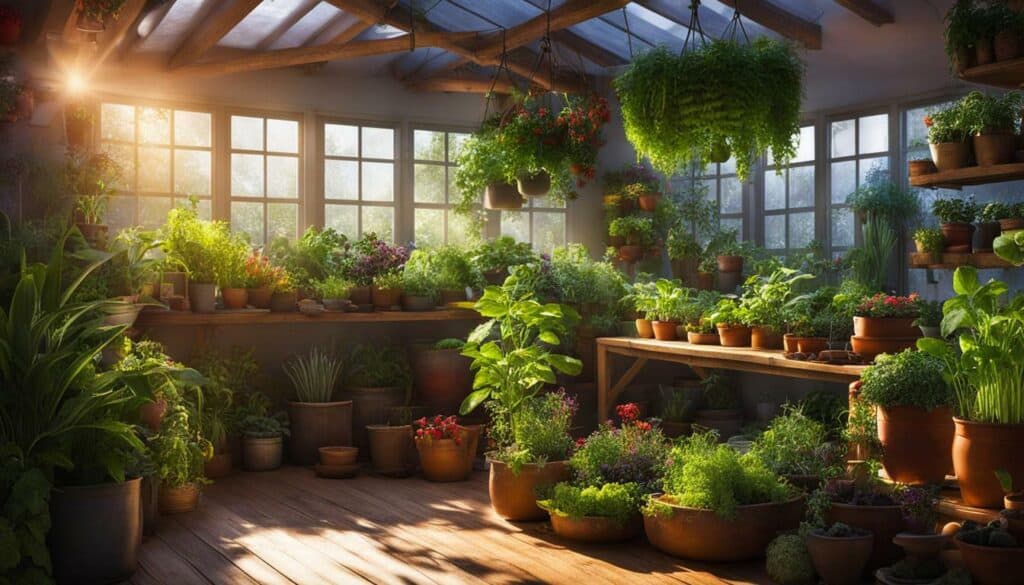
Year-Round Planting: Extend Your Gardening Season
With proper planning and some helpful tips, you can enjoy gardening year-round. One of the most important factors to consider when embarking on year-round planting is selecting plants that are suitable for your climate and space. Some plants thrive in cooler temperatures, while others require more warmth and sunlight. Researching optimal planting times for specific plants is crucial for a successful year-round garden.
In addition to plant selection, understanding soil science and composting is crucial for maintaining a healthy garden. Composting organic matter can improve soil quality and provide nutrients for plants. It’s also important to have the right tools and equipment, such as a spade, pruners, and gloves, for a smooth gardening experience.
Proper garden layout and watering techniques are important for plant growth. Placing plants in the right location based on their light and shade requirements is essential for optimal growth. Watering techniques can vary based on the plant, but ensuring they receive enough water without overwatering is key.
Regular maintenance, including pruning and pest management, is necessary for a thriving garden. Researching different pest management methods and utilizing natural options can protect your plants from common pests.
While traditional outdoor gardening may not be possible for all, indoor gardening options are a creative way to extend your gardening season. Cultivating vegetables indoors, including lettuce, herbs, and tomatoes, allows for fresh produce year-round. Learning about indoor plant care and utilizing different gardening styles, such as hydroponic or container gardening, can provide additional options for indoor gardening enthusiasts.
It’s also important to research optimal planting times for specific plants and learn about harvesting techniques. For example, planting garlic in the fall and harvesting in late spring can yield a bountiful crop.
Joining gardening communities and seeking guidance from experienced gardeners can provide valuable insights for year-round planting and gardening in general. The Green Thumb Guide and Port Farms’ Five-Step Beginner’s Guide to Gardening are comprehensive resources for gardening enthusiasts.
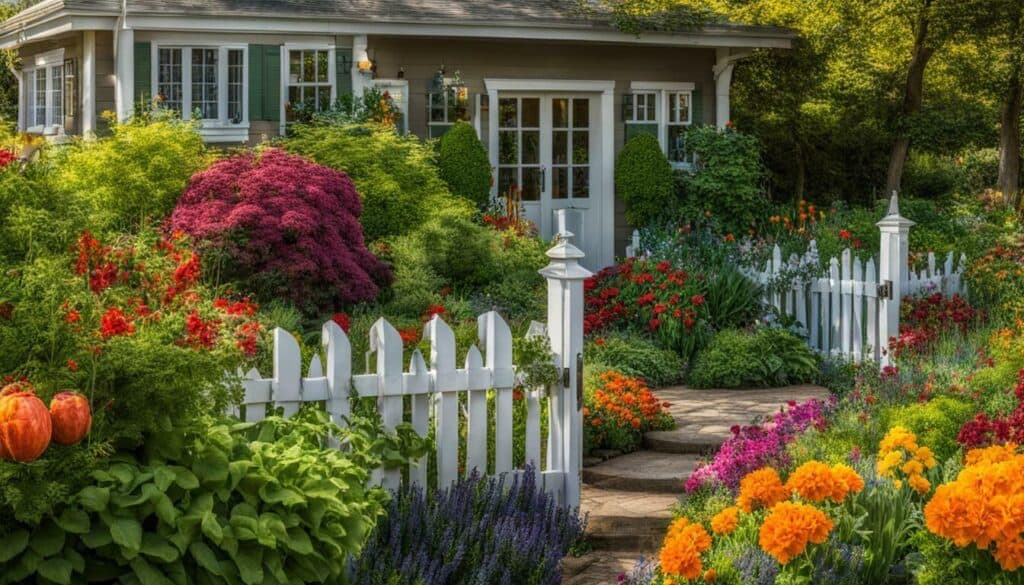
Overall, year-round planting offers the opportunity to create a vibrant and thriving garden regardless of space limitations. With some careful planning and attention to plant selection, soil science, and maintenance, year-round gardening can be a rewarding and enjoyable experience.
Troubleshooting Common Gardening Issues
Every gardener encounters obstacles, but knowing how to troubleshoot common issues can make all the difference. Whether you’re dealing with yellowing leaves, pests, or diseases, understanding the underlying causes and taking proactive measures can help you overcome these challenges and keep your garden thriving.
The first step to troubleshooting common gardening issues is selecting the right plants for your climate and space. Consider factors like sunlight availability and water demands to ensure your plants have the best chance of success. Healthy soil is also crucial, so take the time to understand soil types, drainage, and nutrient balance to provide a flourishing environment for your plants.
Equipping yourself with the right tools is essential, as is effective planning and layout of your garden. Regular maintenance, proper watering techniques, and pest management are all key elements to address common gardening issues. Educate yourself on identifying and combatting common problems like pests and diseases, and don’t be afraid to seek advice from experienced gardeners or join gardening communities for additional guidance.
By taking a proactive approach to troubleshooting common gardening issues, you can overcome obstacles and create a vibrant, thriving garden in any space. With the right knowledge and skills, you can ensure your plants stay healthy and happy year-round.
Joining Gardening Communities for Support and Inspiration
Joining gardening communities can provide valuable support and inspiration for beginners on their gardening journey. These communities offer a platform for like-minded individuals to share experiences, seek advice, and learn from seasoned enthusiasts both offline and online.
In terms of support, gardening communities provide a space where individuals can connect with others who share their passion for gardening. Whether you have a spacious garden or just a small balcony, these communities can offer guidance on how to make the most of your space and provide encouragement throughout your gardening journey. By joining these communities, you can tap into a wealth of knowledge and experience from fellow gardeners who have faced similar challenges.
In addition to support, gardening communities also offer a great source of inspiration. By sharing their own experiences and success stories, members of these communities can inspire others to try new gardening techniques, experiment with different plant varieties, and explore innovative design possibilities. By being a part of these communities, you can gain access to a wide range of ideas and insights that can help you elevate your gardening skills and create a vibrant and thriving garden.
Some tips for joining gardening communities include:
- Join local gardening clubs: Local gardening clubs often organize events, workshops, and plant exchanges, providing an opportunity to connect with fellow gardeners in your area.
- Participate in online forums: Online gardening forums allow you to interact with a diverse group of gardeners from all over the world. These forums often have sections dedicated to different gardening topics, making it easy to find answers to specific questions.
- Follow gardening blogs and social media accounts: Many gardening enthusiasts share their experiences and expertise through blogs and social media platforms. By following these accounts, you can stay updated on the latest trends, tips, and techniques in the gardening world.
- Attend gardening workshops and events: Many gardening communities organize workshops, seminars, and garden tours. These events provide an opportunity to learn from experts, network with fellow gardeners, and discover new plants and techniques.
Joining gardening communities can be a rewarding experience as it allows you to connect with others who share your passion for gardening. Whether you’re looking for support, inspiration, or a platform to share your own knowledge, these communities can provide the resources and camaraderie needed to enhance your gardening journey. So don’t hesitate to join a gardening community and start reaping the benefits of being part of a supportive and inspiring group of individuals.
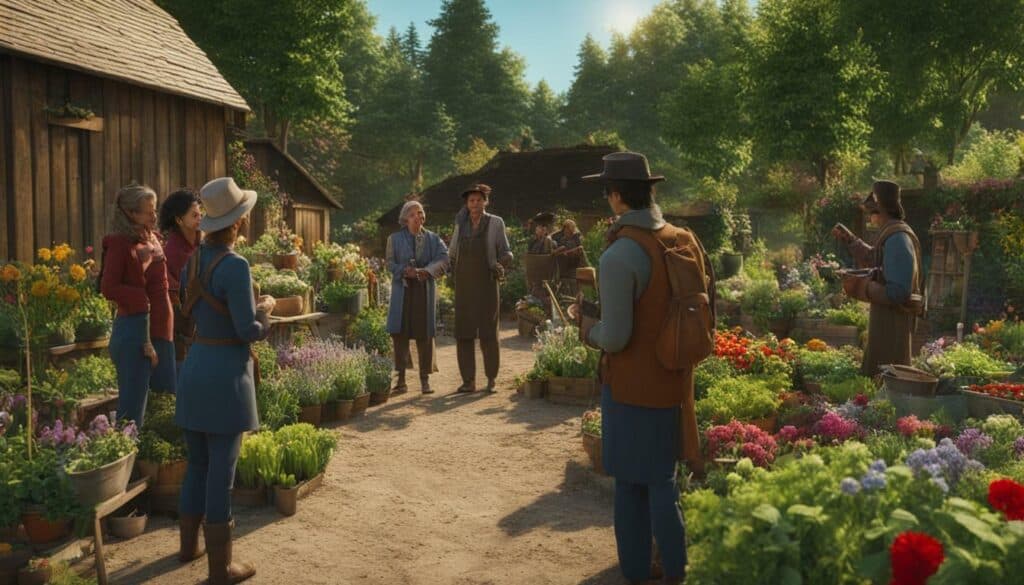
Conclusion
In conclusion, gardening may seem intimidating at first, but with the right knowledge and resources, even beginners can develop a green thumb and create their own stunning gardens. Regardless of the size of your outdoor space, there are ways to reconnect with nature and enjoy the therapeutic benefits of gardening.
Choosing the right plants for your climate and space is crucial, as is understanding the basics of soil science and composting. Having the necessary tools and equipment is also essential for successful gardening, and planning is key to creating a thriving garden.
Watering, pruning, and pest management are fundamental for maintaining a healthy garden. There are various design possibilities and styles to explore, including indoor gardening for those with limited outdoor space. Different seasons offer opportunities for planting and harvesting a variety of fruits, vegetables, and herbs.
When faced with challenges, troubleshooting common issues and seeking support from gardening communities can be helpful. Finally, embracing the journey of gardening with patience and dedication will lead to the creation of a vibrant and thriving garden.
FAQ
Q: What topics does “The Ultimate Guide to Gardens for Dummies: Green Thumb Made Easy” cover?
A: The guide covers various topics, including plant selection, soil science, essential tools, garden layout, watering techniques, pest management, design possibilities, indoor gardening, year-round planting, harvesting tips, troubleshooting common issues, and joining gardening communities.
Q: Does the guide provide tips for gardening in limited outdoor spaces?
A: Yes, the guide offers tips for gardening in limited outdoor spaces, emphasizing the importance of embracing challenges and providing ideas for maximizing space.
Q: Are there tips for watering plants?
A: Yes, the guide provides information on watering techniques and frequency to ensure healthy plant growth and prevent common watering mistakes.
Q: Are there natural pest control methods provided?
A: Yes, the guide offers natural pest control methods for beginners to protect their gardens from common pests without the use of harmful chemicals.
Q: Does the guide cover indoor gardening?
A: Yes, the guide delves into the world of indoor gardening, providing tips for cultivating vegetables indoors and successful indoor plant care.
Q: Does the guide provide guidance on troubleshooting common gardening issues?
A: Yes, the guide addresses common gardening issues and offers troubleshooting tips to help beginners overcome challenges in their gardens.
Q: Are there recommendations for joining gardening communities for support?
A: Yes, the guide highlights the benefits of joining gardening communities, including access to additional guidance and support for beginners.
How Does the Gardening Technique Guide Help Beginners Develop a Green Thumb?
Many beginners struggle to develop a green thumb when starting their gardening journey. However, with the help of a reliable gardening technique guide, these novice gardeners can receive valuable advice on cultivating plants, ensuring healthy growth, and fostering an appreciation for nature. This comprehensive guide offers practical techniques and useful tips for those eager to improve their gardening skills and ultimately achieve success in their green endeavors.
Source Links
- https://portfarms.com/finding-your-green-thumb/
- https://medium.com/@mohammed.touson/gardening-for-beginners-a-comprehensive-guide-to-cultivating-your-green-thumb-8bfd4f73e3a9
- https://www.amazon.ca/GREEN-THUMB-GUIDE-ULTIMATE-GARDENING-ebook/dp/B0CCMPT8TL
- https://www.dummies.com/article/home-auto-hobbies/garden-green-living/gardening/vegetables/vegetable-gardening-for-dummies-cheat-sheet-209497/
- https://www.amazon.com/Flower-Gardening-Beginners-Essential-Landscape/dp/B09FWNWDJZ
- https://www.amazon.com/Companion-Planting-Complete-Rewarding-Beginners/dp/B093KNBPQL
- https://www.dummies.com/article/home-auto-hobbies/garden-green-living/gardening/general-gardening/how-to-choose-and-grow-perennial-flowers-193849/
- https://www.homesandgardens.com/gardens/best-plants-for-beginners
- https://www.realhomes.com/advice/how-to-choose-plants-for-your-garden
- https://www.finegardening.com/project-guides/gardening-basics/the-basics-of-soil-biology
- https://www.permaculturenews.org/2014/08/04/soil-science-basics-beginners/
- https://www.soils.org/about-soils/basics
- https://healthiersteps.com/12-essential-gardening-tools-for-beginners/
- https://www.gardenerbasics.com/blog/garden-tools-and-their-uses
- https://www.gardenersworld.com/product-guides/growing/essential-gardening-tools-list/
- https://www.dummies.com/article/home-auto-hobbies/garden-green-living/gardening/general-gardening/designing-your-vegetable-garden-193659/
- https://www.dummies.com/article/home-auto-hobbies/garden-green-living/gardening/organic/tips-for-designing-a-garden-plan-193676/
- https://simplysmartgardening.com/garden-design-how-to/
- https://extension.umn.edu/how/watering-vegetable-garden
- https://www.hgtv.com/outdoors/gardens/planting-and-maintenance/the-proper-way-to-water-your-garden
- https://www.thespruce.com/tips-for-watering-plants-5198467
- https://www.lifeopedia.com/pest-control-dummies/
- https://www.amazon.com/Naturally-Bug-Free-Gardening-Beginners-ebook/dp/B00L1WBQW2
- https://www.amazon.com/Naturally-Bug-Free-Gardening-Beginners/dp/1500516775
- https://minnetonkaorchards.com/indoor-gardening-for-beginners/
- https://naturezedge.com/the-starter-guide-to-indoor-gardening
- https://www.amazon.com/Indoor-Gardening-Dummies-Beautiful-Vegetables/dp/B09F1HZQ5C
- https://www.tenthacrefarm.com/year-round-gardening/
- https://www.almanac.com/video/how-create-year-round-vegetable-garden
- https://www.almanac.com/vegetable-gardening-for-beginners
- https://www.gardeningchannel.com/gardening-tips-for-common-garden-problems-and-mistakes/
- https://growinginthegarden.com/garden-troubleshooting-guide-how-to-identify-solve-common-garden-problems/
- https://www.gardeners.com/how-to/join-a-community-garden/8846.html
- https://seewhatgrows.org/start-community-garden-neighborhood/
- https://www.homefortheharvest.com/community-garden-tips/
- https://www.wikihow.com/Start-a-Garden
- https://www.chargerpress.com/home/gardening-for-dummies

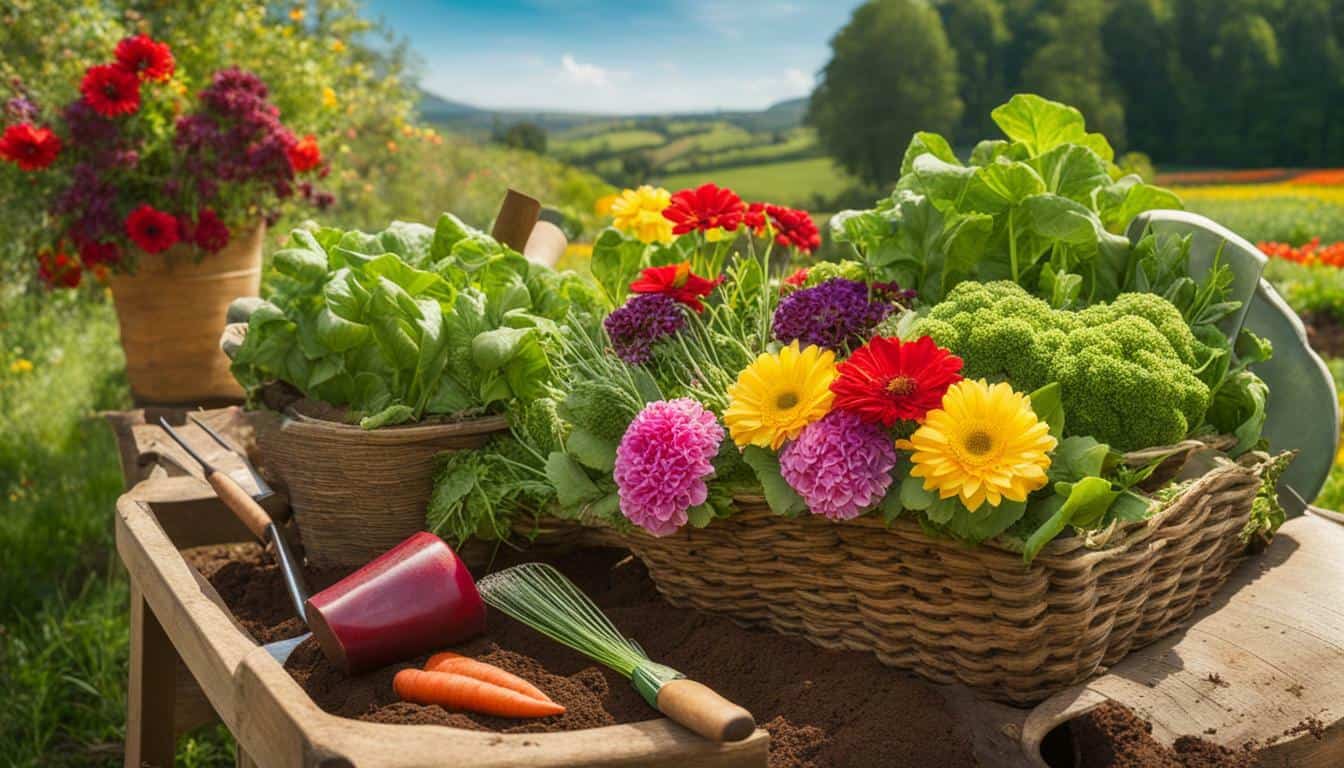



Leave a Reply